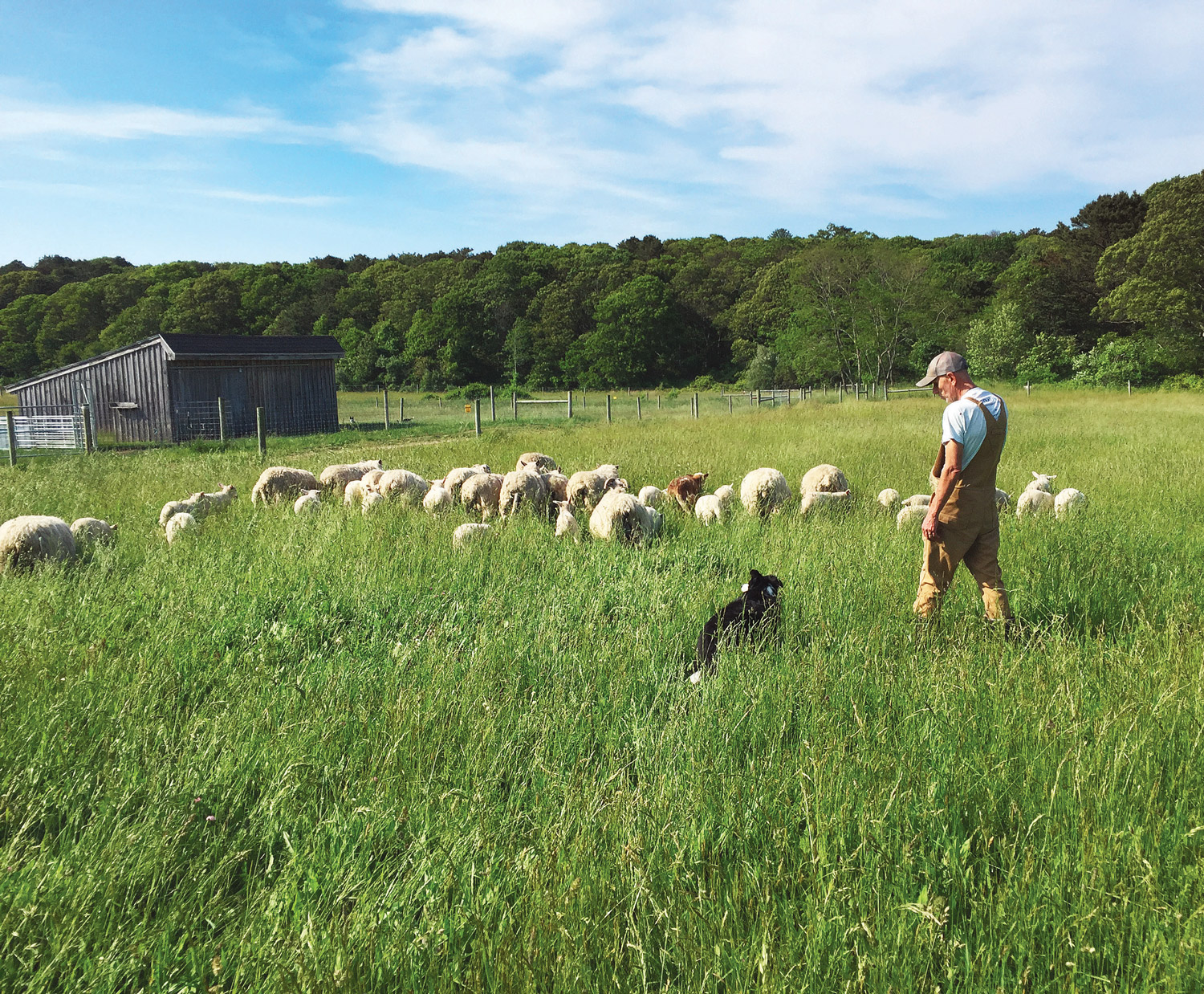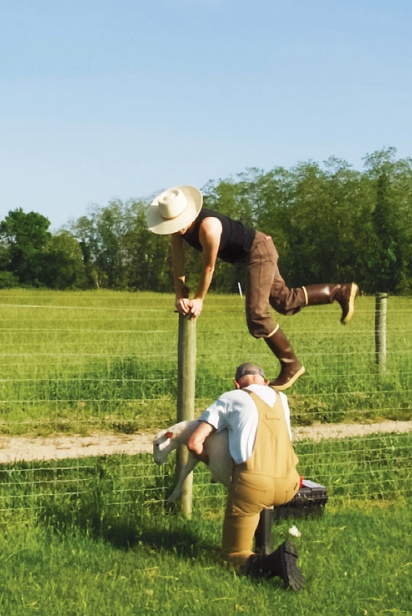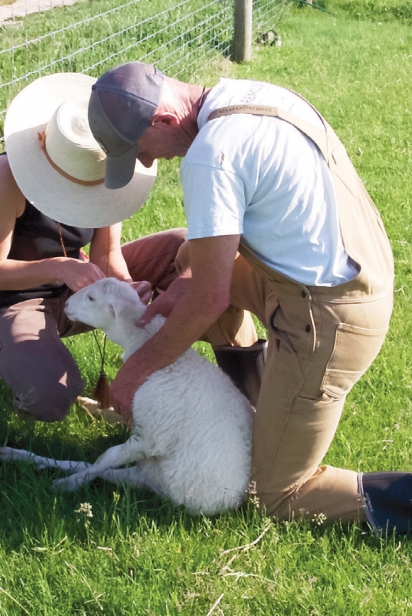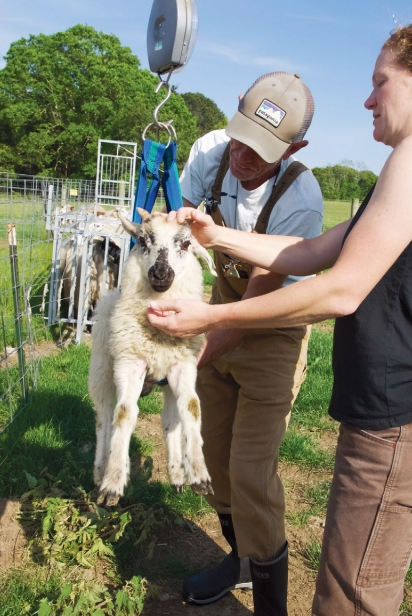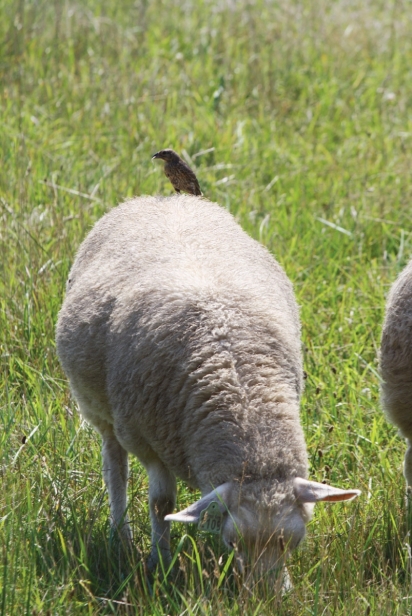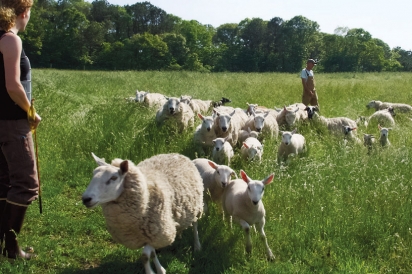Sheep Count: The Gifts of a Grazing Flock
Talk about a unique way to wind down from work.
Woods Hole Oceanographic Institution (WHOI) researchers and friends Diana Wickman and Simon Thorrold bookend all of their days with early morning and evening visits to Falmouth’s Peterson Farm, where they moonlight as tenant shepherds.
Located on the well-used Woods Hole Road, just a few miles shy of the Steamship Authority’s Martha’s Vineyard ferry dock, this eight-eight-acre tract was acquired by the town in 1998 to preserve as conservation land. Originally granted to John Weeks in 1679, the subsequent generations of his family cared for this property, one of the Cape’s earliest farms, for over two hundred years, using it primarily for grazing cattle and sheep, raising crops and maintaining orchards. In the late 1800s and early 1900s, as demand for their primary product, wool, plummeted, they moved on to other professions. Purchasing it in 1949, Capt. John Peterson used the farmland to grow vegetables and fruit for his Cape Codder hotel until the farm’s sale twenty-three years ago.
A multi-layered ecosystem, Peterson Farm is a lovely, rocky and wooded parcel, adjacent to the Beebe Woods, a larger nearly four-hundred-acre swath of conservation land also owned by the town of Falmouth. Peterson Farm has a trail to Ice House (Miles) Pond that passes by the foundation of the property’s original barn. Fox, deer and coyote traverse the area, with salamanders and box turtles arriving as seasonal visitors. A pristine viewpoint from which to watch many migrating birds, there’s also an onsite otter’s marsh.
The goal is to honor the history of the land; essentially keeping a part of it as a functioning working farm. This includes preserving the areas of open space by the rotational grazing of sheep on these fields. Environmentally this galvanizes the root systems of the growing plants, making them excellent carbon sinks. Plus, it’s a win for the sheep, as moving to different pastures with taller grasses can help avoid parasite infestation as most of the parasite larvae they could consume is usually found in the first two inches of plant growth. Committed to the farm’s overarching mission, Wickman and Thorrold do whatever is needed year-round to raise and maintain a flock of sheep — now numbering about five dozen — on a section of the property equaling about twelve acres.
A robotics engineer who designs and troubleshoots the movement of autonomous underwater vehicles for WHOI, Wickman orchestrates their paths, working remotely from hundreds of miles away. Growing up in Connecticut raising horses, she initially learned about sheep husbandry from five years she spent as a volunteer with the previous farm tenant, veterinarian Dr. Sue Schoen. “Shepherding,” says Wickman, “is all in the details. Being flock animals, sheep are flighty but very kind. I love them.”
Arriving in Falmouth two decades ago to study at WHOI, Thorrold never left. An ocean ecologist, he now focuses on large pelagic species like shark, swordfish and tuna. His bio on the farm’s website includes being a Kiwi. A Kiwi, one learns, is not only New Zealand’s official bird, but the term for anyone who hails from there. “With five million people yet twenty-six million sheep where I lived, we all had to know whose sheep were whose,” says Thorrold. “We New Zealanders are very proud of our fences.”
Finding the daily farm tasks a nice way to be outdoors and switch gears from her day job, when Wickman learned of Schoen’s plan to relocate to Western Massachusetts, Wickman and friend Thorrold decided to apply to be the joint stewards of the Peterson property. Thorrold’s wife Andrea, who raises cut flowers for sale, and daughter Phoebe, as well as Wickman’s husband Nick Lee, were onboard and all occasionally lend a hand at the farm.
As the grazing areas exist within a larger public space that includes bicycle and walking trails, everyone who visits the well-used destination is welcomed to experience the value of agriculture. Wickman and Thorrold love the interaction with their community, admitting to passionately talking about their pursuits to anyone strolling by who may be interested.
Offering both meat and wool products to the public on their website, Peterson Farm educates the public by reinforcing our collective local connection to land, the food we consume, and to products like sheep wool that add value and comfort to our lives.
Presently the pair concentrate on three breeds of sheep, including Katahdins, named for the mountain in Maine near where they originated around 1950; Scottish Blackface, which actually come from south of Scotland; and North Country Cheviots from Scotland. Each year they fine-tune the varieties they choose to raise, selecting those that will thrive best on the particular site they are grazing, both in terms of the animal’s health and the attributes they are raising them for — namely meat, wool and sheepskins.
Granted, the sheep population in Falmouth is not quite that of his homeland, yet Thorrold, and Wickman as well, would be hard-pressed to manage this little flock without their border collies. Initially meeting one another while out walking their dogs, the pair is united in affection for their herding dogs, each owning two that arrive at the farm with them daily. Wickman works the fields with Abel (male) or Floss (female), and Thorrold with Dempsey (female) or Quin (male), while the alternates rest in a separate pen isolated from the action. Having a farm where they both can train their dogs in sheep herding and keep those skills acute is one of the perks earned for the hours they commit to this avocation.
Beginning with twenty lambs their first year in, they’ve tripled that amount in three years. Dedicated to the health of each flock, this duo is hands-on every step of the way, from lambing to each lamb’s final day on the property, including what Wickman has dubbed “sheep pedicures”. Adding to the knowledge of their own experiences, they network with other shepherds. Two people in particular that they frequently contact are also practicing veterinarians. YouTube is another great resource, with Thorrold noting that one can search just about anything sheep related and get strong advice.
Safeguarding the lineage of the sheep on the farm takes care. The pair castrates the males of the flock themselves while they are very young, to prevent interbreeding. This keeps the genetic pool of the flock favorable, preventing brothers and sons from impregnating their sisters and mothers. “Unlike the females who are sexually mature at about a year old, many males are able to father at three months of age,” explains Wickman.
Lambs are humanely processed for sale twice a year in June and November, at Meatworks in Westport, MA, a USDA-inspected processing facility with the highest humane handling and animal welfare standards. Pre-orders for purchases of half-a-lamb shares sell out locally in days from their Peterson Shepherds website. Lamb sausages, either chorizo or sweet Italian seasoned, are available in the winter months and, says Wickman, “It is quite possibly our best-selling product and people wait each year for it to become available. It’s really fantastic and a great way to get into lamb for folks who are new to it.”
They also offer a few non-food items, including their North Country Cheviot Sheepskins. The skins are tanned responsibly at Wisconsin’s all-women Driftless Tannery, and returned to the farm to be sold locally. Comforters filled with the farm’s wool, as well as wool dryer balls and wool-stuffed nesting balls for birds are also available. Even though these products provide some revenue, expenses abound, including costs for fencing, hay, seasonal sheering, medicines and other supplies. “Because the property is open to the public, we also need to cover a liability policy,” says Thorrold. “Even with the best planning, things could happen.”
The townspeople have strongly backed the venture. An ongoing GoFundMe page has provided for the winter hay costs. Volunteer crews pitch in for periodic invasive species removal days. The town paid for the cedar shakes to reshingle the barn that it owns, with the shepherds providing the labor, enabling the structure to now house supplies for the farm. The shepherds can also fill and store the bags of wool here that will eventually puff up the duvets they will offer for sale. Raised on a dairy farm, and with a gap year spent on a sheep farm, Thorrold has plenty of hands-on experience. Recently, to reinforce the property borders from predators, he led the installation of three hundred wooden fence posts — heavy timbers that should last three decades.
Like cattle, sheep are ruminant animals that get their nutrition from plant matter. After a sheep chews grass, it enters the first chamber of a four-part stomach, where it can begin to ferment. Soon this pre-digested food, called the “cud”, is regurgitated back into the mouth, where it is re-chewed before it can then proceed further into the digestive tract to nourish the animal.
An obstacle Wickham and Thorrold face since taking over the property is managing the health of the acreage itself, which includes areas of very poor quality and acidic land. Except for the hay they’re fed in the wintertime, for most of the year, from May through November, the sheep are able to munch completely from the Peterson Farm fields, in large part because of the shepards’ hard work. They labor to improve the quality of the soil which, in turn, yields higher quality plants, the two mechanically remove the invasive species which plague the property with a pickax. To enrich the dirt and create a more nutrient-dense growing medium for the grasses, the sheep’s own poop is the most highly valued amendment. “We treasure every last drop of their manure and distribute it over the fields, which, in turn, yields higher quality plants for the sheep to eat.” says Wickham, “It’s black gold.”
Other challenges?
Last year brought the COVID pandemic, a bout with Coccidiosis (a parasitic disease affecting young lambs) and very little rain. “It’s always really tough lambing in drought periods,” says Thorrold. “It was not super sad to leave 2020 behind us.”
“Sometimes, in a rare moment, we may miss closing a gate, and then,” laughs Wickman, “There go all your sheep booking down a running trail leaving us yelling for our dogs.”
As for inclement weather, Falmouth’s winters are generally fine. There’s a cozy barn on the property to keep them safe from freezing rain that could become quite an issue if it got them dangerously cold. “Yet if it’s simply snow,” says Wickman, “they’re really quite pleased to be out in it.”
Thorrold adds, “When the sheep are happy, I’m happy.”
Peterson Farm
119 Woods Hole Road, Falmouth
Peterson Shepherds
PetersonShepherds.org
PetersonShepherds@gmail.com
Instagram


